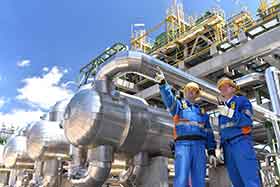 Master Bond adhesives, sealants and coatings are able to be widely employed in the construction of many types of air pollution control equipment. Our application specific products have enabled the design of innovative devices that have played a valuable role in reducing the harmful effects of air pollution. This machinery has been most beneficial in protecting the environment and preventing serious damaging consequences to human health. Some examples of hazardous air pollutants consist of carbon monoxide, sulfur dioxide, nitrogen dioxide, lead, ozone, methane, chlorofluorocarbons, and particulate matter. Appraisal of risk of human exposure to inhaled air pollutants depends on the type, concentration, duration, and frequency. In addition to health ramifications, the economic repercussions from air pollutants have ranged from lower productivity to surging health expenditures.
Master Bond adhesives, sealants and coatings are able to be widely employed in the construction of many types of air pollution control equipment. Our application specific products have enabled the design of innovative devices that have played a valuable role in reducing the harmful effects of air pollution. This machinery has been most beneficial in protecting the environment and preventing serious damaging consequences to human health. Some examples of hazardous air pollutants consist of carbon monoxide, sulfur dioxide, nitrogen dioxide, lead, ozone, methane, chlorofluorocarbons, and particulate matter. Appraisal of risk of human exposure to inhaled air pollutants depends on the type, concentration, duration, and frequency. In addition to health ramifications, the economic repercussions from air pollutants have ranged from lower productivity to surging health expenditures.
Typical air pollution control equipment includes but are not limited to:
- scrubbers
- air filters
- incinerators
- mist collectors
- catalytic reactors
- biofilters
- electrostatic precipitators
Mitigation of greenhouse gas emissions, especially those emitted by fossil fuels (e.g. gasoline, coal etc.) are vital to limit the rapid increase in the temperature of our planet. The impact of global warming is enormous, wide-ranging and dangerous. Stationary air pollution control equipment plays a prominent role in inhibiting the discharge of greenhouse gases for the following industrial facilities:
- oil and gas refineries
- paper mill
- coating and printing factories
- chemical processing plants
- automotive factories
- power plants
- waste management
- mining
- metallurgic plants
- fertilizer plants
- textile mills
- cement plants
Master Bond’s line of non-solvent, low VOC (volatile organic content) based products have the ability to help engineers of mobile air pollution control devices for trucks, buses, passenger cars, cycles, aircraft, marine vessels, locomotives, and snow equipment. Even though much progress has been achieved, many obstacles remain. Minimizing air pollution from mobile sources is of the utmost importance in attaining climate change objectives. Master Bond is working tirelessly to modify existing systems to obtain optimum results, which can then be utilized in various emerging technologies to meet stringent new goals. These efforts extend from engine/fuel management, evaporative emission controls, thermal management to temperature sensors, fuel cell technology, particulate filters and control of engine exhaust emissions.
